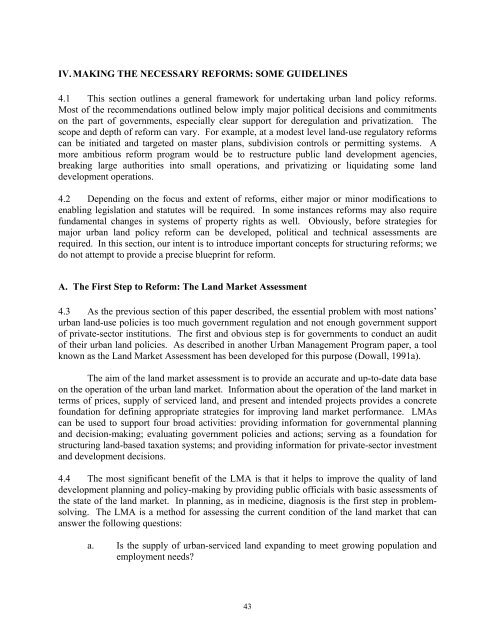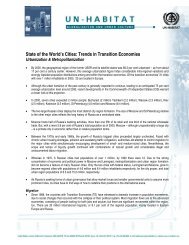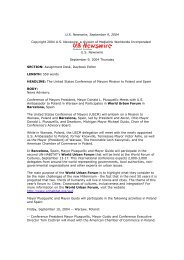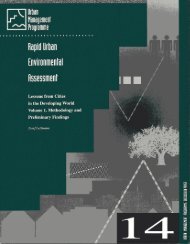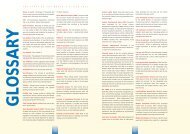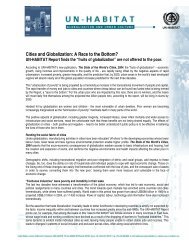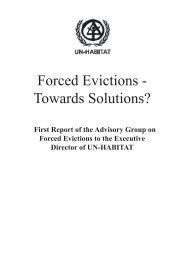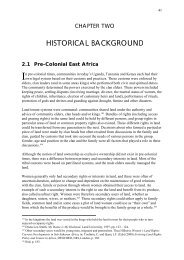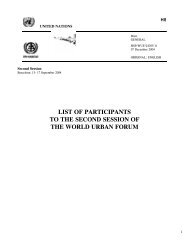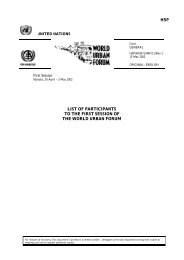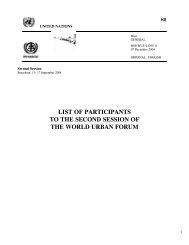a framework for reforming urban land policies in ... - UN-HABITAT
a framework for reforming urban land policies in ... - UN-HABITAT
a framework for reforming urban land policies in ... - UN-HABITAT
Create successful ePaper yourself
Turn your PDF publications into a flip-book with our unique Google optimized e-Paper software.
IV. MAKING THE NECESSARY REFORMS: SOME GUIDELINES<br />
4.1 This section outl<strong>in</strong>es a general <strong>framework</strong> <strong>for</strong> undertak<strong>in</strong>g <strong>urban</strong> <strong>land</strong> policy re<strong>for</strong>ms.<br />
Most of the recommendations outl<strong>in</strong>ed below imply major political decisions and commitments<br />
on the part of governments, especially clear support <strong>for</strong> deregulation and privatization. The<br />
scope and depth of re<strong>for</strong>m can vary. For example, at a modest level <strong>land</strong>-use regulatory re<strong>for</strong>ms<br />
can be <strong>in</strong>itiated and targeted on master plans, subdivision controls or permitt<strong>in</strong>g systems. A<br />
more ambitious re<strong>for</strong>m program would be to restructure public <strong>land</strong> development agencies,<br />
break<strong>in</strong>g large authorities <strong>in</strong>to small operations, and privatiz<strong>in</strong>g or liquidat<strong>in</strong>g some <strong>land</strong><br />
development operations.<br />
4.2 Depend<strong>in</strong>g on the focus and extent of re<strong>for</strong>ms, either major or m<strong>in</strong>or modifications to<br />
enabl<strong>in</strong>g legislation and statutes will be required. In some <strong>in</strong>stances re<strong>for</strong>ms may also require<br />
fundamental changes <strong>in</strong> systems of property rights as well. Obviously, be<strong>for</strong>e strategies <strong>for</strong><br />
major <strong>urban</strong> <strong>land</strong> policy re<strong>for</strong>m can be developed, political and technical assessments are<br />
required. In this section, our <strong>in</strong>tent is to <strong>in</strong>troduce important concepts <strong>for</strong> structur<strong>in</strong>g re<strong>for</strong>ms; we<br />
do not attempt to provide a precise bluepr<strong>in</strong>t <strong>for</strong> re<strong>for</strong>m.<br />
A. The First Step to Re<strong>for</strong>m: The Land Market Assessment<br />
4.3 As the previous section of this paper described, the essential problem with most nations’<br />
<strong>urban</strong> <strong>land</strong>-use <strong>policies</strong> is too much government regulation and not enough government support<br />
of private-sector <strong>in</strong>stitutions. The first and obvious step is <strong>for</strong> governments to conduct an audit<br />
of their <strong>urban</strong> <strong>land</strong> <strong>policies</strong>. As described <strong>in</strong> another Urban Management Program paper, a tool<br />
known as the Land Market Assessment has been developed <strong>for</strong> this purpose (Dowall, 1991a).<br />
The aim of the <strong>land</strong> market assessment is to provide an accurate and up-to-date data base<br />
on the operation of the <strong>urban</strong> <strong>land</strong> market. In<strong>for</strong>mation about the operation of the <strong>land</strong> market <strong>in</strong><br />
terms of prices, supply of serviced <strong>land</strong>, and present and <strong>in</strong>tended projects provides a concrete<br />
foundation <strong>for</strong> def<strong>in</strong><strong>in</strong>g appropriate strategies <strong>for</strong> improv<strong>in</strong>g <strong>land</strong> market per<strong>for</strong>mance. LMAs<br />
can be used to support four broad activities: provid<strong>in</strong>g <strong>in</strong><strong>for</strong>mation <strong>for</strong> governmental plann<strong>in</strong>g<br />
and decision-mak<strong>in</strong>g; evaluat<strong>in</strong>g government <strong>policies</strong> and actions; serv<strong>in</strong>g as a foundation <strong>for</strong><br />
structur<strong>in</strong>g <strong>land</strong>-based taxation systems; and provid<strong>in</strong>g <strong>in</strong><strong>for</strong>mation <strong>for</strong> private-sector <strong>in</strong>vestment<br />
and development decisions.<br />
4.4 The most significant benefit of the LMA is that it helps to improve the quality of <strong>land</strong><br />
development plann<strong>in</strong>g and policy-mak<strong>in</strong>g by provid<strong>in</strong>g public officials with basic assessments of<br />
the state of the <strong>land</strong> market. In plann<strong>in</strong>g, as <strong>in</strong> medic<strong>in</strong>e, diagnosis is the first step <strong>in</strong> problemsolv<strong>in</strong>g.<br />
The LMA is a method <strong>for</strong> assess<strong>in</strong>g the current condition of the <strong>land</strong> market that can<br />
answer the follow<strong>in</strong>g questions:<br />
a. Is the supply of <strong>urban</strong>-serviced <strong>land</strong> expand<strong>in</strong>g to meet grow<strong>in</strong>g population and<br />
employment needs?<br />
43


